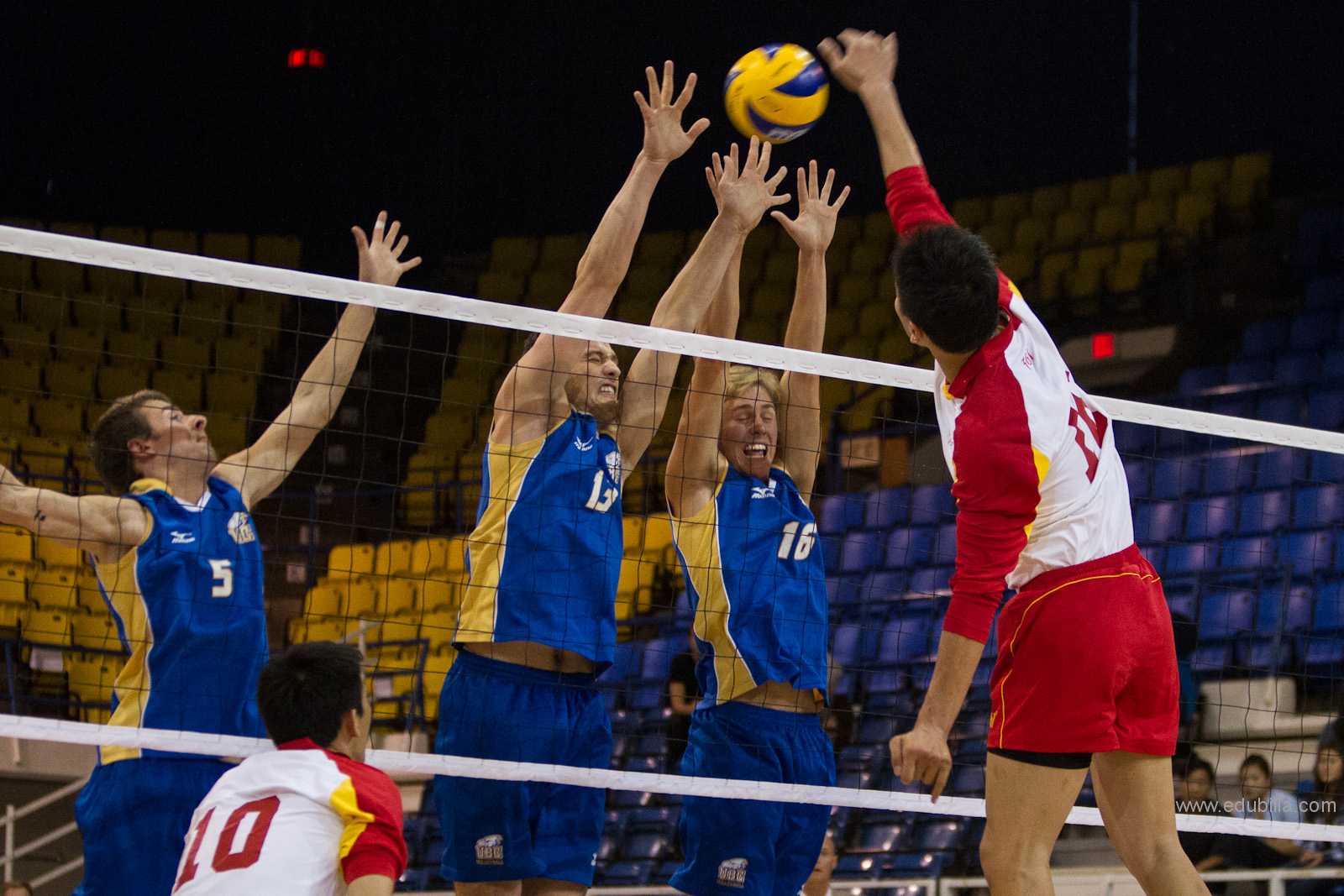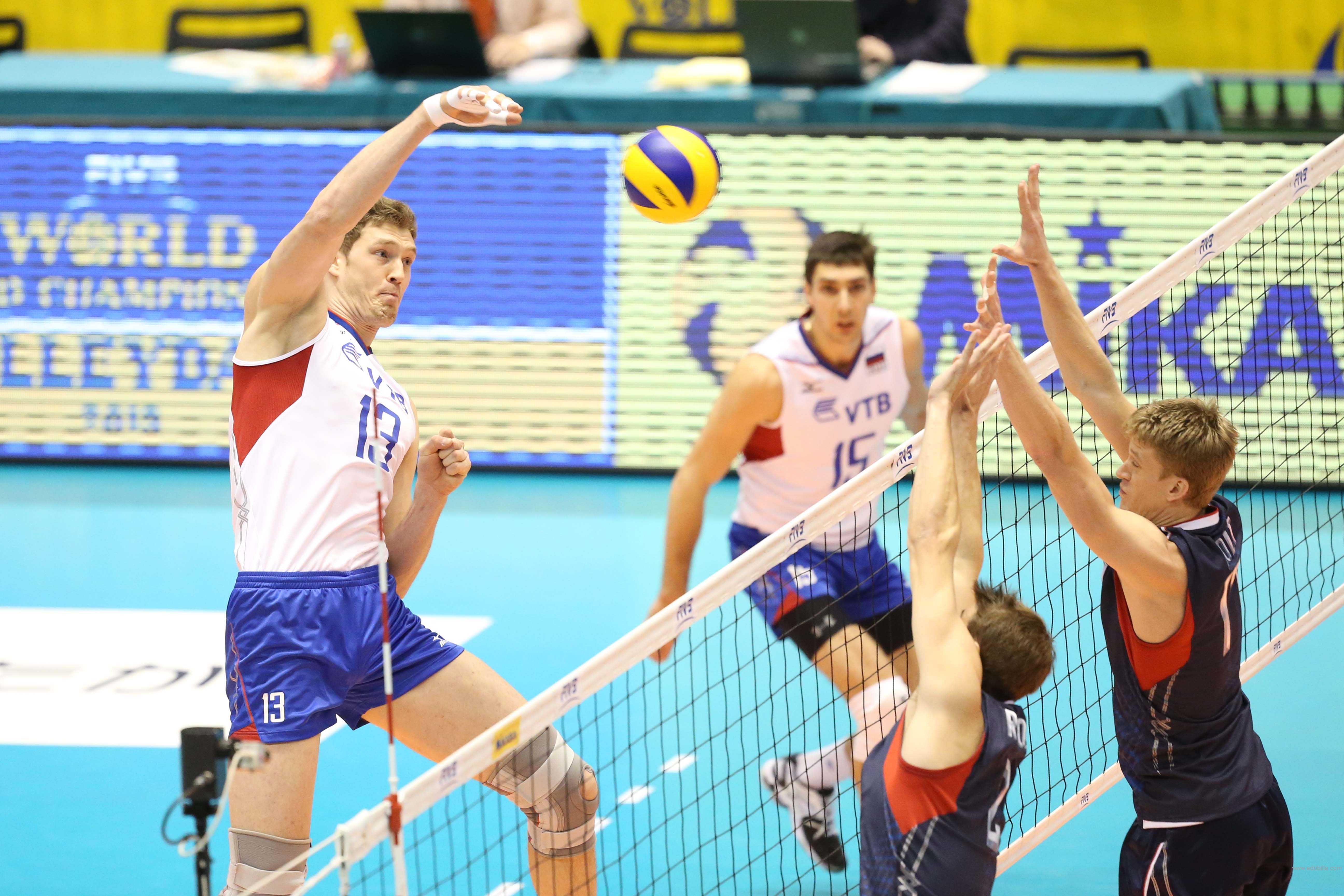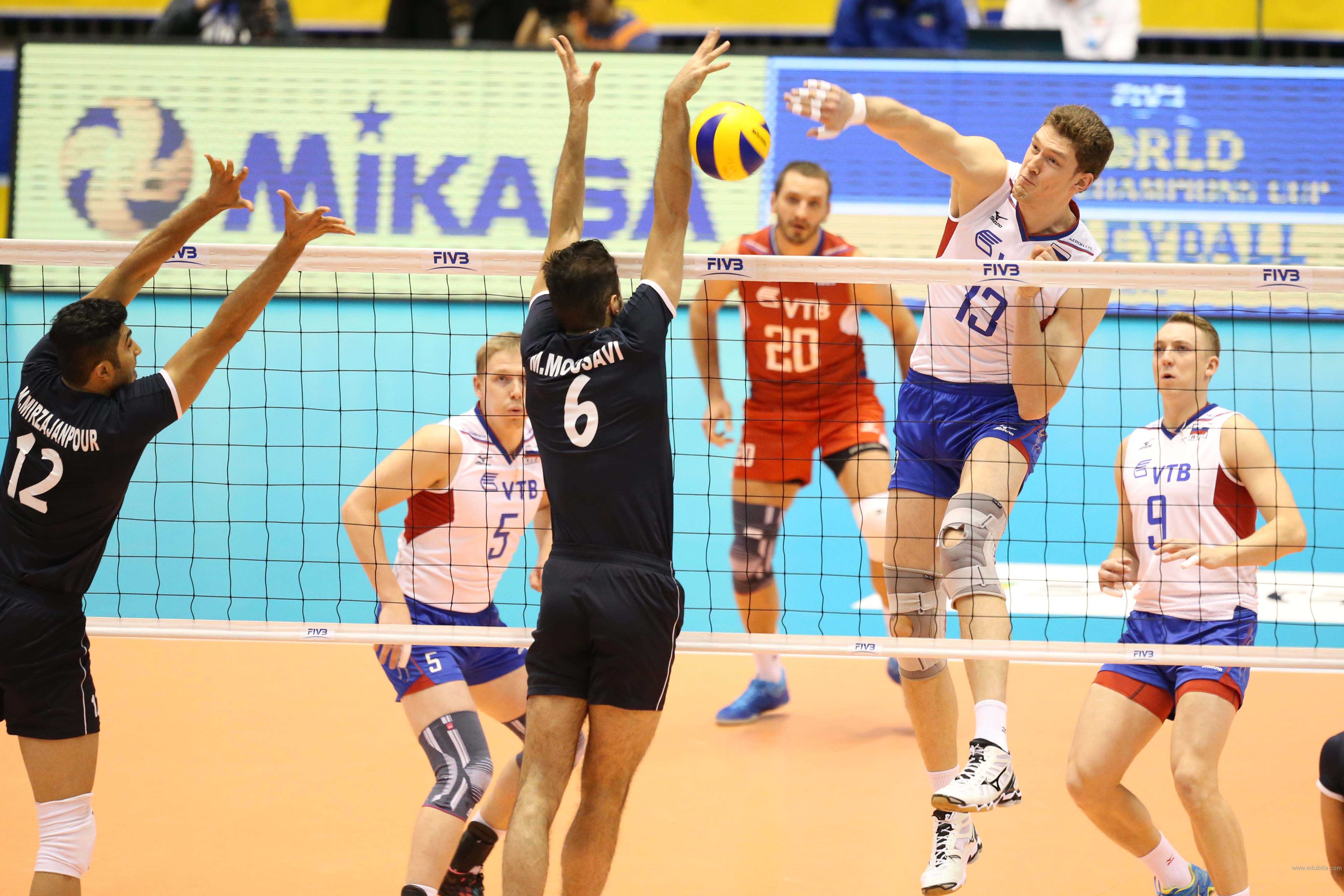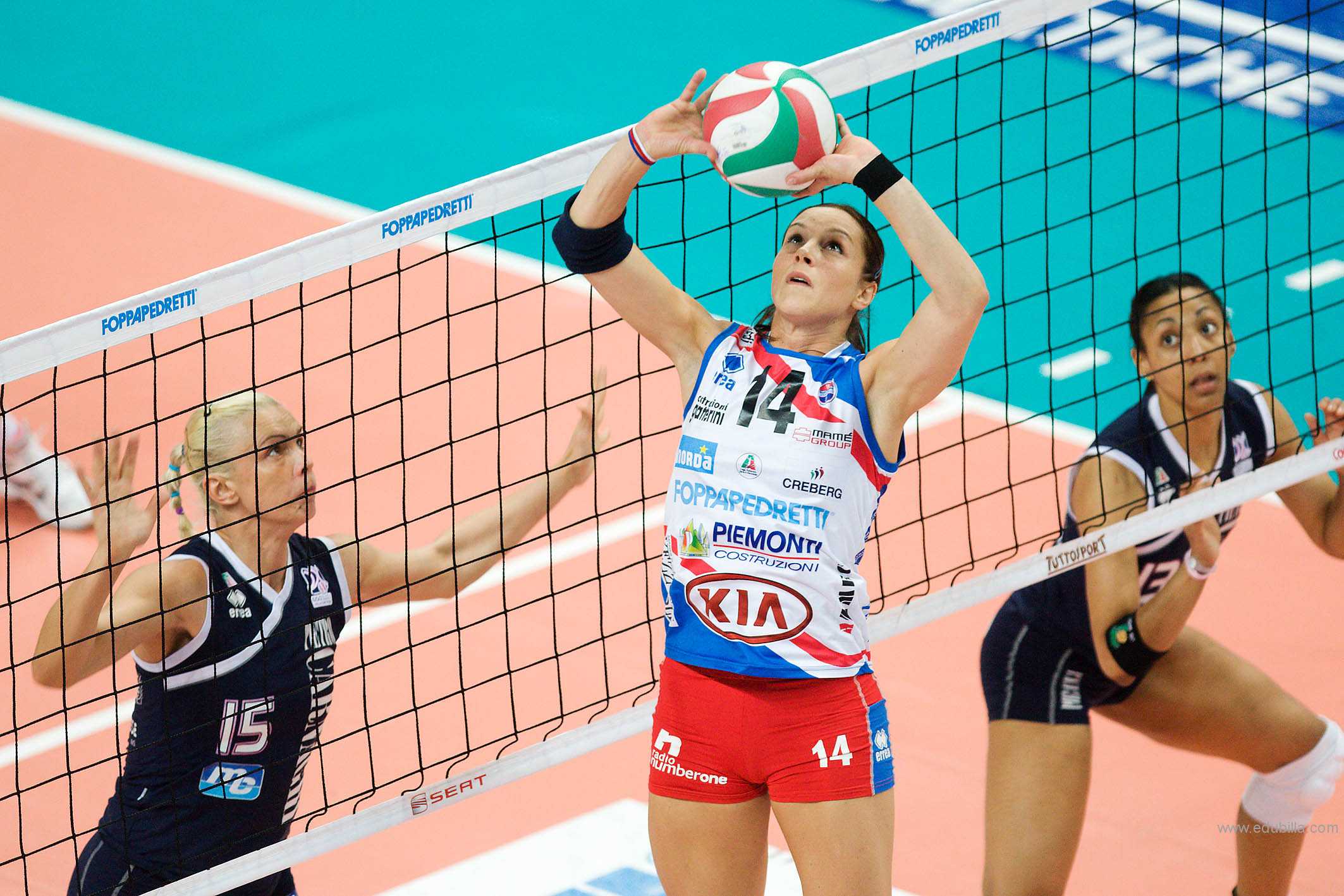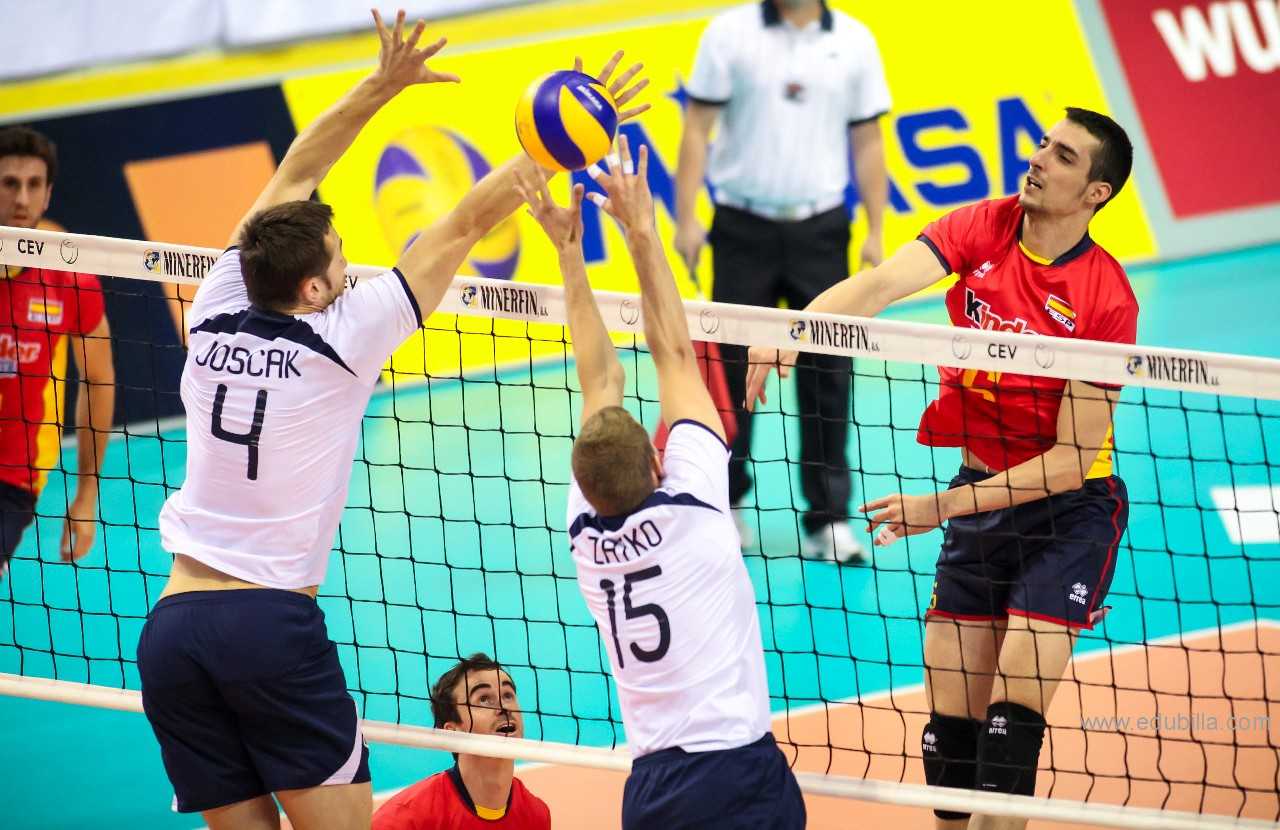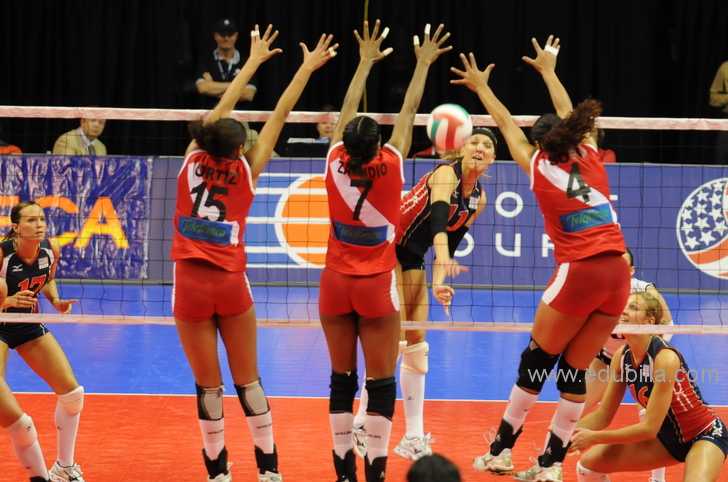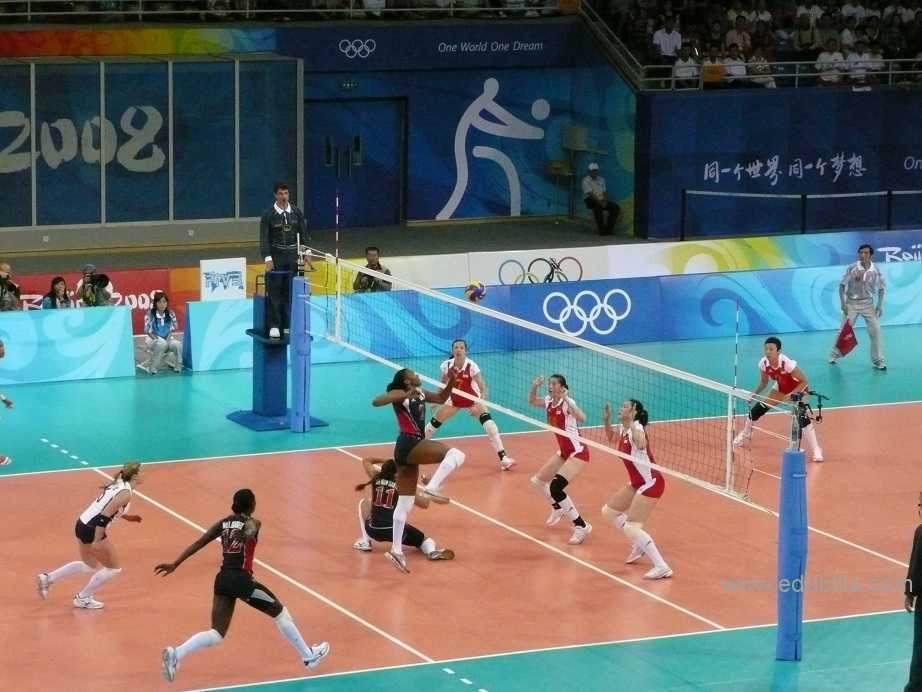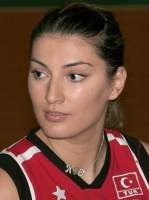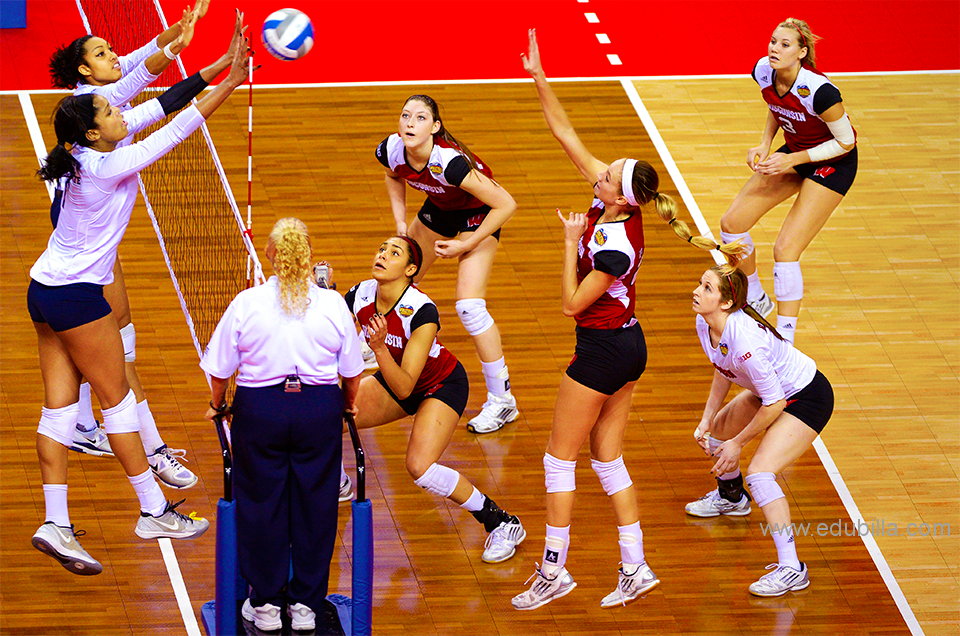
Overview Of Volleyball
Volleyball is a team sport in which two teams of six players are separated by a net. Each team tries to score points by grounding a ball on the other team's court under organized rules.It has been a part of the official program of the Summer Olympic Games since 1964.
The complete rules are extensive. But simply, play proceeds as follows: a player on one of the teams begins a 'rally' by serving the ball (tossing or releasing it and then hitting it with a hand or arm), from behind the back boundary line of the court, over the net, and into the receiving team's court. The receiving team must not let the ball be grounded within their court. The team may touch the ball up to 3 times but individual players may not touch the ball twice consecutively. Typically, the first two touches are used to set up for an attack, an attempt to direct the ball back over the net in such a way that the serving team is unable to prevent it from being grounded in their court.
The rally continues, with each team allowed as many as three consecutive touches, until either
(1): a team makes a kill, grounding the ball on the opponent's court and winning the rally; or
(2): a team commits a fault and loses the rally. The team that wins the rally is awarded a point, and serves the ball to start the next rally.
A few of the most common faults include:
-causing the ball to touch the ground or floor outside the opponents' court or without first passing over the net;
-catching and throwing the ball;
-double hit: two consecutive contacts with the ball made by the same player;
-four consecutive contacts with the ball made by the same team;
-net foul: touching the net during play;
-foot fault: the foot crosses over the boundary line when serving.
The ball is usually played with the hands or arms, but players can legally strike or push (short contact) the ball with any part of the body.
A number of consistent techniques have evolved in volleyball, including spiking and blocking (because these plays are made above the top of the net, the vertical jump is an athletic skill emphasized in the sport) as well as passing, setting, and specialized player positions and offensive and defensive structures.
Game Rules
The objective in volleyball is to keep the ball from striking the floor on your side of the net and return it so that it strikes the floor on your opponent’s side, before they can return it.
Play:
-The ball is put into play by the right back position (1) from behind
the rear boundary line using either an underhand or overhand serve.
-The serve must go over the net within the court boundaries on the
other side. A serve that hits the net and still goes over to the other side
is a good serve and referred to as a “let serve”.
-The ball can only be played with 3 touches, per team, per play, and
then must be sent over the net. The ball can go over the net with less
then 3 touches without penalty.
-The ball may not be hit 2 times in a row by any one player.
-Only front row players are allowed to contact the ball above the net
with intention to attack. However, a back row player may attack the
ball upon the net if they are behind the 10 ft. line.
-If the serving team loses the serve (ball lands on their own side or ball
is hit out of bounds), the other team obtains service and a point. This
is called a side out/point.
-A ball that lands on the boundary line is considered “in”.
-For every side out made, the team that is awarded the serve must
rotate in a clockwise manner.
-If the ball hits the ceiling and goes over the net, it is a dead ball. If the
ball hits the ceiling and falls back onto the original side, it is playable
if there are still hits available.
-In rally scoring, a point is awarded at the end of every play no matter
who is serving.
-Each game is played to 25 points and the winning team must win by at
least 2 points.
-The match is a best of 5 contest.
Court and equipment:
-The court is 60 ft. long and 30 ft. wide
-The boundary lines are 2 inches wide.
-A 4 inch line divides the court at 30 ft.
-A men’s net is 8 ft. high
-A women’s net is 7 ft. 4 1/8 inches.
Court Positions:
- Right back
- Center back
- Left back
- Left front
- Center front
- Right front
Volleyball Terminology:
1. Block: Defensive play by the player(s) in the front row who place
their hands and arms above the net so that a spiked ball rebounds into
the opponents court.
2. Pass: The forearm pass made on balls below the waist.
3. Game Point: The last point in any game.
4. Set: The overhead pass using the fingertips of an open hand
5. Rotation: The shifting of players, clockwise, just before a new person
serves.
6. Attack: An approach to the net, a vertical jump, and a forceful hit of
the ball down onto the opponent’s court.
7. Touch: When a player attempts to block the ball unsuccessfully and it
continues onto their own side of the court. This does not count as one
of the 3 hits allowed per side.
8. Tip: Attempting to “trick” the defense by dumping the ball right over
the net.
9. Defensive specialist (DS): A player who only plays in the back row.
10.Libero: A DS that wears a different color jersey from the rest of the
team that can enter the back row ONLY for any player throughout the
game. This does not count against the teams substitution count.
11. Substitution: At a dead ball opportunity, the coach signals the
referee that he/she would like to make a player change. In volleyball,
once a player subs in for another player, they cannot return in the game for a different player. A total of 18 substitutions are allowed per
game.
Detailed Volleyball Rules Can Be Downloaded From Documents
Equipments Need For Volleyball
The Ball:
The standard volleyball is made of leather or synthetic leather, weighs between 9 and 10 ounces and has a circumference of 25.6 to 26.4 inches. The ball has a rubber bladder and can be one color or a combination of colors. Synthetic leather is lighter and is fine for beginner players. Junior volleyballs for children 12 years old and younger weigh between 7 and 8 ounces.
The Net and Court:
The outdoor volleyball court measures 18 x 9 m, surrounded by a free zone that is 2 meters wide on all sides. The minimum playing space for U.S. volleyball competitions is 7 meters. The volleyball net is 32 feet long by 3 feet wide. For women, the net should be 7 feet, 4 1/8 inches high. For men, the net should be 7 feet, 11 5/8 inches high. U.S. regulation volleyball playing surfaces must be flat and not present any hazards to the players.
Lines
The playing court is marked by two sidelines and two end lines. All lines must be 2 inches wide and must be created with a light color that is easy to discern from the playing court. An attack line should be placed three meters from the center line. The center line divides the court into two 9 x 9 meter courts.
Posts and Cables:
The volleyball net structure is held together with metal cables and posts. Posts are placed 0.5 to 1.0 meter outside the sidelines and 2.55 meters high. Posts should be round, smooth and padded, to prevent injury to the players should they dive or crash into them. Metal wires and cables may need to be covered if it is determined that they present a danger to the players.
Antenna and Side Bands:
Antenna are flexible rods that are 1.8 meters long made of fiberglass, fastened at the outer edge of each side band. Side bands are two white bands attached vertically to the net and placed above each sideline.
Knee pads:
Knee pads should be sturdy enough to protect your knees from falls, slides and dives, but flexible enough to allow you to bend comfortably. Your volleyball knee pads must be made of fabric that breathes and manages moisture. Good quality pads have a gel or foam shock-absorbing material that will cover and protect your patella. It is best to purchase your pads from a reliable sporting goods store that will allow you to try them on. If you have difficulty finding the right fit, have the store professional measure you and order custom-fit pads. Popular volleyball knee pad brands include Asics, Mizuno, adidas, Nike and Mikasa.
Shoes:
Arch and ankle support is key when choosing a volleyball shoe. Mizuno, Asics and Nike are just a few of the popular brands of volleyball shoes, which are lightweight, allowing you to be faster on your feet, as well as bearing good shock absorption on your toes. Volleyball shoes also provide for better lateral movement than typical running or cross-training shoes.
Clothing and Jewelry:
All clothing should be lightweight to allow maximum flexibility and breath-ability, as well as made of a material that absorbs sweat and keeps skin dry. Spandex shorts are a good option, as they are flexible, light and absorb odor. Socks, while not required, absorb sweat and prevent blisters. Jewelry is not permitted in volleyball, with the exception of smooth wedding bands. Glasses must be worn with a strap to keep them secure.
Detailed Volleyball Equipments Can Be Downloaded From Documents
History Of Volleyball
In 2014, the sport of Volleyball is 119 years old!
The sport originated in the United States, and is now just achieving the type of popularity in the U.S. that it has received on a global basis, where it ranks behind only soccer among participation sports.
Today there are more than 46 million Americans who play volleyball. There are 800 million players worldwide who play volleyball at least once a week.
In 1895, William G. Morgan, an instructor at the Young Men's Christian Association (YMCA) in Holyoke, Mass., decided to blend elements of basketball, baseball, tennis, and handball to create a game for his classes of businessmen which would demand less physical contact than basketball. He created the game of Volleyball (at that time called, mintonette). Morgan borrowed the net from tennis, and raised it 6 feet 6 inches above the floor, just above the average man's head.
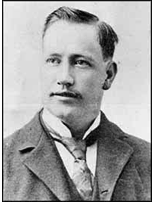
Origin Of Volleyball
On February 9, 1895, in Holyoke, Massachusetts (USA), William G. Morgan, a YMCA physical education director, created a new game called Mintonette as a pastime to be played (preferably) indoors and by any number of players. The game took some of its characteristics from tennis and handball. Another indoor sport, basketball, was catching on in the area, having been invented just ten miles (sixteen kilometers) away in the city of Springfield, Massachusetts, only four years before. Mintonette was designed to be an indoor sport, less rough than basketball, for older members of the YMCA, while still requiring a bit of athletic effort.
The first World Championships:
The first World Championships were organised in 1949 for Men and 1952 for Women and both have remained the biggest events in volleyball, along with the Olympic Games, since 1964. The world competitions immediately generated enthusiasm, and the number of players and National Federations affiliated with the FIVB grew by leaps and bounds. Volleyball fever had caught on just about everywhere and increased rapidly. FIVB promoted events began to multiply.
The First Olympic volleyball tournament:
The history of Olympic volleyball traces back to the 1924 Summer Olympics in Paris, where volleyball was played as part of an American sports demonstration event.After the foundation of FIVB and some continental confederations, it began to be considered for official inclusion. In 1957, a special tournament was held at the 53rd IOC session in Sofia, Bulgaria to support such request. The competition was a success, and the sport was officially included in the program for the 1964 Summer Olympics.
The First World Cup:
In 1965, Poland hosted the first World Cup for Men before Uruguay hosted the first World Cup for Women in 1973. Following the first two editions for Men and the first edition for Women, Japan gave new life to Men’s and Women’s World Cups by staging the third and second editions respectively in 1977. From there on until today, with the sponsorship of Fuji Television, the quadrennial World Cup has become a major event and qualifies three teams for the Olympic Games.
The First Rules:
The first rules, written down by William G Morgan, called for a net 6 ft 6 in (1.98 m) high, a 25 ft × 50 ft (7.6 m × 15.2 m) court, and any number of players. A match was composed of nine innings with three serves for each team in each inning, and no limit to the number of ball contacts for each team before sending the ball to the opponents’ court. In case of a serving error, a second try was allowed. Hitting the ball into the net was considered a foul (with loss of the point or a side-out)—except in the case of the first-try serve.
The First volleyball:
1896, July 7th - at Springfield College the first game of "volleyball" was played.
The First official ball:
The first official ball used in volleyball is disputed; some sources say that Spalding created the first official ball in 1896, while others claim it was created in 1900.The rules evolved over time: in the Philippines by 1916, the skill and power of the set and spike had been introduced, and four years later a "three hits" rule and a rule against hitting from the back row were established. In 1917, the game was changed from 21 to 15 points. In 1919, about 16,000 volleyballs were distributed by the American Expeditionary Forces to their troops and allies, which sparked the growth of volleyball in new countries.
Governing Bodies
The International Federation of Volleyball, commonly known by the acronym FIVB, is the international governing body for the sport of indoor, beach and grass volleyball.Its headquarters are located in Lausanne, Switzerland and its current president is Ary Graca.
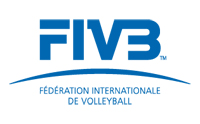
The Founding of FIVB:
A decisive moment in the history of volleyball’s first 100 years was certainly that of the founding of the FIVB (Federation Internationale de Volleyball) when in April 1947 representatives of 14 countries (Belgium, Brazil, Czechoslovakia, Egypt, France, Netherlands, Hungary, Italy, Poland, Portugal, Romania, Uruguay, USA and Yugoslavia) met in Paris under the leadership of France’s Paul Libaud to found the FIVB. Mr. Libaud, President of the French Federation, was elected first President of the FIVB. The headquarters were established in Paris, where they remained for the first 37 years until 1984 when Mexico’s Dr. Rubén Acosta took over the Presidency from Libaud.
FIVB Activities:
The FIVB's main activity is worldwide planning and organisation of volleyball events, sometimes in conjunction with other international governing bodies such as the IOC. This involves defining qualification procedures and competition formulae for tournaments, as well as more specific details such as player line-up and replacement restrictions, venues and hosts.
Amongst others, the FIVB organises the following international volleyball tournaments:
-Olympic Games
-World Championship
-World Cup
-World Grand Champions Cup
-World League (Men)
-World Grand Prix (Women)
-Club World Championship
and the following international under-age volleyball tournaments:
-Men's U23 World Championship
-Women's U23 World Championship
-Men's U21 World Championship (Junior)
-Women's U20 World Championship (Junior)
-Boys' U19 World Championship (Youth)
-Girls' U18 World Championship (Youth)
and the following international beach volleyball tournaments:
-Olympic Games
-World Championships
-World Tour
The FIVB also participates directly in the organization of continental volleyball events which have an attached international significance, such as Olympic and World Championship continental qualification tournaments.
FIVB Today and Tomorrow:
The FIVB consists of 220 affiliated federations and governs,manages and promotes all forms of volleyball and beach volleyball worldwide through tournaments such as the World Championships, World League, World Grand Prix, World Cup, Grand Champions Cup, Club World Championships, FIVB Swatch World Tour, FIVB Swatch World Championships, Beach Volleyball Continental Cup and Beach Volleyball World Cup, Junior and Youth tournaments and, of course, the Olympics.
To Visit FIVB Click Here.
Awards Related To Volleyball
OVA(Ontario Volleyball Association)Awards:
Celebrating Volleyball for Life in Ontario, the OVA holds a bi-annual OVAtions Award banquet to honour those volunteers and corporate partners that have distinguished themselves through the years by providing their time, effort and support to the promotion and development of volleyball in the province.
Volunteer Awards:
DOUG ROBBIE VOLUNTEER OF THE YEAR AWARD:
Presented to the individual who had a great impact on the promotion and development of volleyball for the OVA at the regional or provincial level in the past year.
DIANE WOOD SPECIAL ACHIEVEMENT AWARD:
Presented to an individual to recognize an outstanding contribution to volleyball at the provincial level for 15 years or more.
ACHIEVEMENT AWARD:
Presented to an individual who has had an impact on volleyball development at the regional or provincial level for 10 years or more.
RECOGNITION AWARD:
Presented to an individual who has been involved in the development of volleyball at the club or provincial level for 5 years or more.
MIKE BUGARSKI MALE COACH OF THE YEAR AWARD:
Presented annually to an outstanding male coach for his success in the previous season and for his contribution to the development of our sport in Ontario.
SANDY SILVER FEMALE COACH OF THE YEAR AWARD:
Presented annually to an outstanding female coach for her success in the previous season and for her contribution to the development of our sport in Ontario.
SENIOR DEVELOPMENT COACH OF THE YEAR AWARD (16U-18U):
Presented annually to two outstanding coaches (one female, one male) for their history in developing senior athletes/teams within the OVA and for their contribution to the development of the sport of volleyball in the province.
JUNIOR DEVELOPMENT COACH OF THE YEAR AWARD (HOUSE LEAGUE, 12U-15U):
Presented annually to two outstanding coaches (one female, one male) for their history in developing junior athletes/teams within the OVA and for her contribution to the development of the sport of volleyball in the province.
PAUL AND SHELLEY BROWNSTEIN BUILDER AWARD:
Presented to an individual who has been involved in the development of volleyball at the provincial level for at least 10 years. Their contribution has been primarily within the broader volleyball communities across Ontario not requiring full OVA membership – schools, recreational centres, multi-sport organizations and any other group that organizes, supports and/or builds volleyball and enhances the OVA’s mission.
SYLVIA JAKSETIC FEMALE OFFICIAL OF THE YEAR AWARD:
Presented annually to a female official who has had a great impact on the promotion and development of both officials and volleyball for the OVA at the regional, provincial and/or national level.
Athlete Awards
SCARBOROUGH SOLARS AWARD:
Awarded annually to a minimum of two (2) Ontario athletes (equal number of male and female athletes) who have been selected to, or who have the ability to, represent Ontario/Canada in international volleyball or beach volleyball competitions. Applications are due on February 1st of each year.
KEN DAVIES MEMORIAL AWARD:
Presented annually at the Ontario Championships to a male Youth Division athlete who best demonstrates the qualities of determination, leadership, athletic ability, sportsmanship and fair play.
EVELYN HOLICK AWARD:
Presented annually at the Ontario Championships to a female Youth Division athlete who demonstrates the qualities of determination, leadership, athletic ability, sportsmanship and fair play.
JASON SENECHAL MEMORIAL AWARD:
The Jason Senechal Memorial Award is presented annually to the Youth Beach Athlete that best demonstrates the qualities of honour, fair play, and sportsmanship. Making this Award all the more special is the fact that it is voted on by one's peers, the athletes of the OVA Beach Tour.
Arjuna Award:
The Arjuna Awards are given by the Ministry of Youth Affairs and Sports, government of India to recognize outstanding achievement in National sports. Instituted in 1961, the award carries a cash prize of INR 500,000, a bronze statuette of Arjuna and a scroll.
Over the years the scope of the award has been expanded and a large number of sports persons who belonged to the pre-Arjun Award era were also included in the list. Further, the number of disciplines for which the award is given was increased to include indigenous games and the physically handicapped category.
The Government has recently revised the scheme for the Arjun Award.As per the revised guidelines, to be eligible for the Award, a sportsperson should not only have had good performance consistently for the previous three years at the international level with excellence for the year for which the Award is recommended, but should also have shown qualities of leadership, sportsmanship and a sense of discipline.
Gatorade Player of the Year awards:
The Gatorade Player of the Year awards are given annually to male and female high-school student-athletes in the United States.They are given for boys' baseball, boys' football, girls' softball, girls' volleyball, boys' basketball, girls' basketball, boys' cross country, girls' cross country, boys' soccer, girls' soccer, boys' track & field, and girls' track & field.
A "State Player of the Year" award is given to the best student-athlete in each of the twelve sports in the District of Columbia and each of the fifty states, where each sport is recognized as an interscholastic sport.Selection is based on three criteria: athletic achievement, academic excellence, and exemplary character (including sportsmanship, and participation in community and other activities). Twelve "National Player of the Year" awards are then given, to the best student-athlete in each of the twelve sports, chosen from the state winners in the respective sport.
Finally, one male Athlete of the Year and one female Athlete of the Year are selected from the twelve National Player of the Year recipients.The two winners are voted on by a national panel that includes approximately 400 sports journalists, coaches, and others.The two athletes of the year receive their awards at a special ceremony prior to The ESPY Awards, in Los Angeles, California
German Volleyball Player of the Year:
The German Volleyball Player of the Year has been chosen annually since 1979 by the readers of the German Volleyball Magazin.
Senior CLASS Award:
The Senior CLASS Award is presented each year to the outstanding senior NCAA Division I Student-Athlete of the Year in women's volleyball. The award was established in 2010 and the first award went to Ellie Blankenship of the Northern Iowa Panthers.
2010-Ellie Blankenship
2011-Kanani Danielson
2012-Gina Mancuso
2013-Ariel Scott
2014-Liz McMahon
Sample Documents Of Volleyball
-Muhammad Ali

